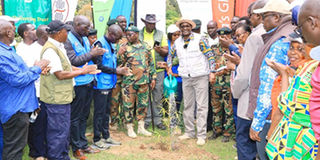Use sports as a platform to fight climate change

The Principal Secretary in the Ministry of Environment and Forestry, Dr Chris Kiptoo, presides over the sixth Kaptagat Annual Tree Planting on July 21,2022. He was accompanied by the Regional and Northern Corridor Principal Secretary Dr Belio Kipsang, the World Marathon Record Holder Dr Eliud Kipchoge, Jackson Kiplagat of WWF, representatives from county governments, various state agencies, civil society, and members of the public.
What you need to know:
- As we bide our time, this present dry conditions is yet another lesson that climate change is real and we should do everything to fight it
- The current dry spell is a wake-up call to our athletes that they should take up the mantle of fighting climate change
- Training fields have also been affected by the lack of rain, exposing athletes to injuries
Ask anyone in Nairobi right now and they will tell you how much the current heat wave has stretched their endurance levels.
It is certainly the hottest weather witnessed in the capital city in recent times, coupled with windy and dusty conditions.
We continue to wait for the long rains in Nairobi even as other areas of the country start receiving them.
As we bide our time, this present dry conditions is yet another lesson that climate change is real and we should do everything to fight it.
Sports has long been touted as an important tool in the fight to save mother earth.
Sportspersons and entities can help influence behaviour change in the masses regarding a sustainable way of living that does not destroy the earth through pollution, cutting of trees, and poor waste disposal, among others.
The current dry spell is a wake-up call to our athletes that they should take up the mantle of fighting climate change. After all, they have been some of the most affected by the dry and dusty conditions.
Many of them would attest to how they have struggled to train or compete in the hot sun.
Some have had to grapple with strong winds blowing dust into their eyes while on the track or while competing on a cross country course.
Too much dust in the atmosphere also leads to poor air quality, which may affect athletes’ lungs or even their endurance levels.
Training fields have also been affected by the lack of rain, exposing athletes to injuries.
Sustainable practices
Undoubtedly, the lack of rain has affected the food supply in the country making it difficult for many sportspersons to get the appropriate diet to improve their physical fitness.
With these side effects in mind, athletes can help fight climate change in various ways. One, they can lead from the front by adopting a sustainable lifestyle in their day-to-day activities and so set an example for the rest of the people around them.
Such sustainable practices include planting trees at home, recycling waste and using renewable energy.
The athletes can also use their celebrity status to preach about the importance of sustainability and the dangers of climate change.
They can do this using platforms such as social media, post-race interviews et al.
In addition, there are various climate change initiatives that athletes can partner with to create awareness.
Becoming a legend and a great sportsperson does not only mean winning medals and titles but also leaving a positive impact in the lives of others as well.
As an athlete, your purpose in this life is way beyond the track or field or pitch; you have the hopes and survival of an entire generation on your shoulders.
Let’s come together and save mother earth using sports as a tool.
Korir is the chairman of Athletics Kenya’s Nairobi branch and Kip Keino Classic meet director.





